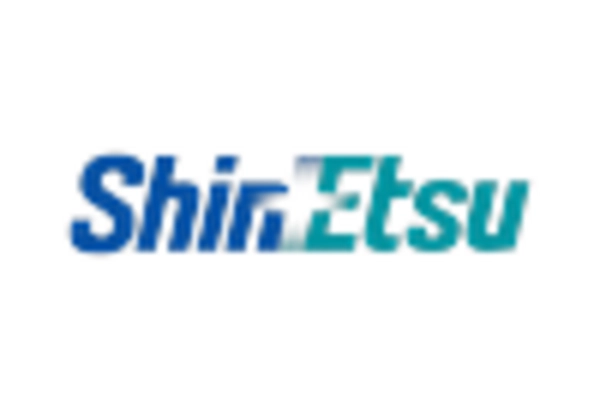Rising Demand in the Food Industry
The food industry is witnessing a rising demand for cellulose derivatives, which is significantly influencing the Cellulose Derivative Excipients Market. These derivatives are widely used as thickening agents, stabilizers, and emulsifiers in various food products, enhancing texture and shelf life. The increasing consumer inclination towards processed and convenience foods is propelling the demand for cellulose derivatives, with the market expected to grow at a rate of 4.2% annually. As food manufacturers continue to innovate and create new products, the reliance on cellulose derivatives as essential excipients is likely to strengthen, contributing to the overall market expansion.
Increasing Pharmaceutical Applications
The Cellulose Derivative Excipients Market is experiencing a notable surge in demand due to the increasing applications of cellulose derivatives in pharmaceuticals. These excipients serve as binders, fillers, and stabilizers in various drug formulations, enhancing the bioavailability and stability of active pharmaceutical ingredients. The market for cellulose derivatives is projected to grow at a compound annual growth rate of approximately 5.2% from 2023 to 2030, driven by the rising need for effective drug delivery systems. As pharmaceutical companies continue to innovate and develop new formulations, the reliance on cellulose derivatives as excipients is likely to expand, thereby bolstering the overall market growth.
Regulatory Support for Biodegradable Excipients
The Cellulose Derivative Excipients Market is benefiting from increasing regulatory support for biodegradable and environmentally friendly excipients. Regulatory bodies are encouraging the use of sustainable materials in pharmaceutical and food applications, which aligns with the properties of cellulose derivatives. This support is likely to foster innovation and investment in the development of new cellulose-based excipients that meet stringent regulatory standards. As sustainability becomes a focal point for manufacturers, the cellulose derivatives market is expected to expand, with a projected growth rate of 5.5% over the next few years, driven by the demand for eco-friendly alternatives.
Growing Consumer Preference for Natural Products
Consumer preferences are shifting towards natural and organic products, which significantly impacts the Cellulose Derivative Excipients Market. As health-conscious consumers increasingly seek products with fewer synthetic additives, cellulose derivatives, derived from natural sources, are gaining traction. This trend is particularly evident in the food and cosmetics sectors, where cellulose derivatives are utilized as thickening agents, stabilizers, and emulsifiers. The market for cellulose derivatives is expected to witness a robust growth trajectory, with an estimated increase of 4.8% in demand over the next five years, as manufacturers respond to consumer demands for cleaner labels and natural ingredients.
Technological Advancements in Manufacturing Processes
Technological advancements in the production of cellulose derivatives are playing a crucial role in shaping the Cellulose Derivative Excipients Market. Innovations in manufacturing processes, such as the development of more efficient extraction and purification techniques, are enhancing the quality and functionality of cellulose derivatives. These advancements not only improve the performance of excipients in various applications but also reduce production costs, making them more accessible to manufacturers. As a result, the market is likely to see an influx of new products and formulations that leverage these enhanced cellulose derivatives, further driving market growth.


















Leave a Comment